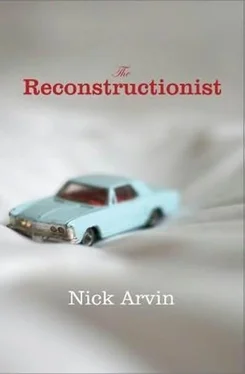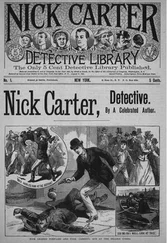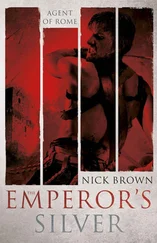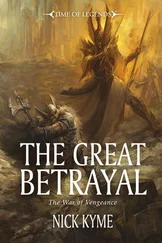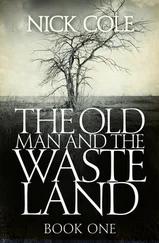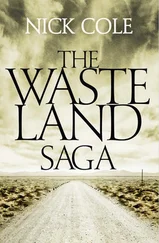‘You all right?’ Boggs asked, slowing a little.
‘Yes.’ Ellis had to fight for breath.
‘Are you sure? I mean, in a bigger sense?’
‘I’m fine.’
‘You don’t have to follow me, you know.’
‘Let me help you!’
Boggs shrugged. His jaw had set hard, and he studied the windshield. Traffic opened before him, and he accelerated a bit. ‘What do you want?’
‘To talk!’ Ellis shouted.
‘Just say it!’
‘What?!’
‘What you have to say!’
‘Let’s sit somewhere!’ Ellis gasped; he couldn’t run like this much longer.
‘What?!’
‘This is stupid!’
‘What is?!’
Ellis cried hoarsely, ‘This isn’t a joke!’
‘No joke!’
‘No!’
‘OK!’ Boggs was accelerating. ‘Havalek thirty twelve!’ he called, then pulled ahead.
Soon he had vanished. Ellis stopped and gasped for a minute with his hands on his knees. Then he turned and walked back along the road and through the golf course. He dodged across the highway lanes. When he reached the motel parking lot, Heather’s car was gone. This made him feel guilty. Then, aggrieved. He didn’t bother to go up to the room. He climbed into the minivan, started it and turned it onto the road. Every job had been filed under a designation based on the last name of the job’s client – like Jim Havalek, a plaintiff’s attorney – followed by a sequential number. Ellis recalled Havalek 3012 pretty clearly: a single-vehicle accident that had occurred about two hundred miles away. He pulled into the flow of traffic and phoned Heather. She said she was driving home. ‘It’s all right,’ she said. ‘Go on. You’re doing the right thing.’ Her voice sounded mechanical, maybe even rehearsed. ‘You know,’ she said, fading, ‘you -’ She began again. ‘You know why I called him John, not Boggs, don’t you? Because he hates it.’
‘Sure,’ he said. He was surprised by the sympathy he felt for Boggs.
THE SUN HAD begun to set when he turned onto a road that followed along the edge of a lush ravine. A stream of water ran at its bottom and it turned and oxbowed and from out of it rose cottonwoods, willows and brush. Ellis drove slowly. He remembered that the place he was looking for came just after the road curved a long left then sharply right. The driver of the accident vehicle, travelling at 60 despite the 45 mph speed limit, had felt the back end break free in the transition between curves, began to swerve, fishtailed with increasing violence and launched into the ravine.
But as the road curved back and forth, back and forth, and the trees and brush of the ravine all looked much the same, Ellis began to doubt whether he could identify the right curve.
But then it was easy. A white-painted cross stood beside the road.
He parked. He had driven here as hard and fast as he dared, hoping that he might have a chance to arrive before Boggs – unless the way Boggs had pulled into traffic from the golf course indicated a recklessness that he could not match. He stood looking around. What had happened here? An idiot had killed his best friend. Was that the reason that Boggs had chosen it?
A photo of a smiling young man clung to the centre of the cross while at its foot lay a scatter of sun-faded plastic flowers. A beaded plastic necklace. Some broken crockery. A Yankees baseball cap slowly interring into the roadside.
A single-vehicle accident involving two occupants, young men, not yet old enough to vote, friends since kindergarten. During the driver’s deposition, an attorney asked how far the steering wheel was turned when the car went off the road.
‘I had let go.’
The attorney said, ‘Excuse me?’
‘I let go of the wheel. And I closed my eyes.’
The car, a little Dodge Neon, helixed into space over the ravine, smashed into the rocky stream bed, overturned and came to rest on the wheels. The driver said he kept his eyes closed – waiting, waiting, waiting, to be sure that the car had stopped and he was alive. Then he opened his eyes and turned to the passenger seat, and it was empty.
The passenger-side window had smashed open.
His friend stood a few feet away.
The two looked at each other. The one standing in the water said, ‘I don’t feel good.’ He sat.
The driver dragged him over to the bank. When the ambulance arrived the EMTs put his friend onto a board and hauled him up to the road. He had no exposed wounds, but he had suffered a laceration of the liver, and twelve hours later, during surgery, he died.
Half of a year passed before Ellis and Boggs were hired and arrived to inspect the vehicle – a dozen energy-drink cans rolling in the rear-seat footwells, worn tyres, no load markings on the seat belts – and then came here to inspect the scene, plodding through the water to find and document bits of broken glass among the rocks, clambering up and down the slope to identify broken branches in the brush, using a machete to hack open view planes for their surveying equipment. Later they built an analytical simulation of the motion of the Dodge as it fishtailed, its subsequent leap, its initial impact with the ground, its crashing rollover. Painstakingly, they accounted for each dent in the sheet metal and the vehicle-to-ground contacts that had deposited window glass as well as the passenger-seat occupant, which allowed them to calculate forces to pass along to biomechanics experts so that those experts could say whether the vehicle’s seat-belt design was likely responsible for the damage to the liver of the passenger seat occupant.
Whose name Ellis would not have remembered except that it was printed on a sticker affixed to the cross:
Rick Elwin
1987-2005
We love you, Foxy!!
A photo showed Rick Elwin with big teeth, a droopy right eyelid, not much chin, and it was not obvious in what sense he might be considered foxy. He smiled but looked a little desolate, as if something in him already anticipated how the photo would be used.
Ellis picked up the baseball cap and beat the dirt off and set it atop the cross. He looked at the road for tracks or markings, but there were only the faint tyre marks his minivan had made in the dirt. He peered into the brush, wondering if Boggs had been down there. He didn’t want to go down. It was muddy and the water was cold, he remembered.
He walked the road, through the S-curve where the driver had lost control. The road had been dry, the tyres worn but not bald, the vehicle otherwise in fine condition. Drug test negative. Just dumb. Not that anyone could say that in court. One could say, too much speed and an inexperienced driver. Possibly the two friends had been screwing around, but if so the driver never let it slip, and he seemed to have been honest otherwise, stricken and bewildered by the death of his friend. And as Ellis walked the curves suddenly, briefly, James Dell’s horrible broken body lay on the ground in front of him.
He turned from it and watched as a Honda went by; it took the turns without difficulty. He crossed the road and stood under high old pines on a broad floor of needles and listened to the trees creak. The sky was darkening. He returned to the cross, and then, cursing, plunged down the side of the ravine to the water’s edge. He took off his shoes, rolled his pants. The water was as cold as he remembered. He lurched through the water until he stood at approximately the location where the Dodge had come to rest.
In the mud was a shoeprint.
Ellis compared it to the size of his own shoe – the print was a bit larger, as Boggs’s would be. He examined the tread, but he could not remember looking closely at Boggs’s shoes recently. He moved upstream and down, looking for more prints, without success. He worked up the ravine slope above the print, but saw nothing, and he went back down and crossed the water and looked along the opposite bank. A heavy gloom gathered. He ended standing in the water where the Dodge had been, his feet numb with cold.
Читать дальше
